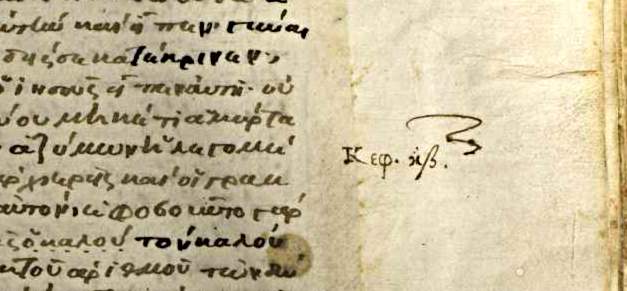MS #GA-69
(Family 13)
Background
Edited Excerpt from Waltz's Online Encyclopedia
Manuscript GA-69
Location:
Leicester, Catologue #: Town Museum Cod. 6 D 32/1
Description (from Ferrar's Intro):
"Whole NT in large folio, 14 3/4" long by 10" wide, written on 91 leaves of vellum and 122 of coarse paper, arranged pretty regularly, so that 2 vellum leaves are followed by 3 of paper, evidently from previous calculation how far the more costly material would hold out. The paper is so bad that four fo the leave would bear writing only on one side. There are 38 lines per page; the instrument seems to have been a reed rather than a pen, and the style of writing is very singular, yet certainly neither elegant nor remarkably perspicuous.
"The smooth and rough breathings are often very hard to distinguish, and e is usually placed in a recumbent posture, so much resembling a that it is not easy to say at all times which was meant. No one who has inspected it has estimated its age earlier than the 14th century.
Scrivener: "We cannot praise the care of the scribe in copying this MS. Many words occur which are only begun, broken off perhaps after the first syllable; and i have counted the large number of 74 omissions from homoioteleuton and the like causes. Yet the accents are represented with much accuracy, and the breathings are regular..."
Ferrar, Intro. vii-viii
Contents
GA-69 contains the entire New Testament with many lacunae. Missing Matt. 1:1-18:15, Acts 10:45-14:17 (the manuscript skips from Acts 10:45 to 14:17 without break; it would appear the scribe did not realize there was a defect in his exemplar here!), Jude 7-25, Rev. 19:10-22:21; Rev. 18:7-19:10 are fragmentary. The manuscript also contains five pages of assorted information about church history and doctrine.
Date/Scribe
Dated paleographically to the fifteenth century, probably to the period 1465-1472, since it was presented to George Neville, Archbishop of York, England during those years. The scribe is known from his other writings to have been Emmanuel, a former resident of Constantinople who spent the second half of the fifteenth century in England copying Biblical and classical texts. His writing style is absolutely peculiar; epsilons closely resemble alphas, and accents are often placed over consonants rather than vowels. Acute and grave accents are confused. Errors are also common; Scrivener counted 74 omissions of various sorts, and many words interrupted in the middle.
The scribe also used the Nomina Sacra in peculiar ways; Ihsous is consistently spelled out until John 21:15, when contractions begin to be used sporadically. The manuscript appears to have been written with a reed. Scrivener also remarks, "Though none of the ordinary divisions into sections, and scarcely any liturgical marks, occur throughout, there is evidently a close connection between Cod. GA-69 and the church service books, as well in the interpolations of proper names, particles of time, or whole passages (e.g. Luke xxii. 43, 44 placed after Matt. xxvi.39) which are common to both...."
A number of marginal notes ("too many," Scrivener acidly remarks) are written in the hand of William Chark, who owned the manuscript probably in the late 16th century.
GA-69 is written on a mix of paper and parchment. The quires are usually of five sheets rather than four, with two parchment and three paper sheets per quire, the parchment leaves being on the outside of the quire. The material is very poor -- so bad that one side of some of the paper leaves had to be left blank. The manuscript has one column per page. The books seem to have originally been in the order Paul (with Hebrews last), non-Biblical materials, Acts, Catholic Epistles, Apocalypse, Gospels.
Description and Text-type
The text of GA-69 varies significantly. In the Gospels it was identified by Ferrar with Family 13, and this has been affirmed by everyone since (Wisse classifies it as 13, and Von Soden put it in Iib). However, some have thought it one of the best Family 13 manuscripts, and others count it one of the poorer. Probably the peculiar readings generated by scribal errors had something to do with this. Within the Ferrar group, it has been placed in the "b" group (along with 174 and 788) by scholars from Von Soden and Lake to Colwell. The Alands, interestingly, classify GA-69 as Category V (Byzantine) -- despite the fact that its profile (1341 631/2 222 50s) seems to be fairly typical for the Ferrar Group (e.g. 13 is 1501 711/2 312 54s; 346 is 1721 821/2 242 53s).
Luke's Gospel:
Luke 21:38: "...αυτου." is followed by Jn 7:53-8:11.
Luke 23:37 contains the Traditional reading: "επ' αυτω γεγραμμενη γραμμασιν Ελληνικοις και Ρωμαικοις και Εβραικοις..." ('over Him a Title was written in letters of Greek and Roman and Hebrew...')
John's Gospel:
Omits 7:53-8:11 but inserts it after Luke ch. 21 (see above).
Acts:
In the Acts even Scrivener concedes the text to be "less valuable." Von Soden classes it as Ia3, but places it among the lower members of the group. The Alands classify it as Category V.
Pauline Epistles:
It is generally agreed that GA-69 and 462 are closely akin in the Pauline Epistles. Their combined text is, however, only slightly removed from the Byzantine. The Alands classify GA-69 as Category III in Paul (they do not categorize 462). Von Soden places GA-69 and 462 next to each other in Ia3. Davies links 462 (and so by implication GA-69) with 330, 436, and 2344; her technique, however, makes these results questionable. There is as yet no clear evidence that GA-69 and 462 should go with any of the stronger members of the Ia3 group, such as Family 330 or 365 and Family 2127.
Catholic Epistles:
In the Catholics the Alands again classify GA-69 as Category V, and Von Soden again classifies it as Ia3. Wachtel lists it as having 10-20% non-Byzantine readings. Richards classifies it as Mw, which makes it a mixed manuscript that does not seem to have any close relatives. This seems to conform with the results of Wachtel.
Revelation:
In the Apocalypse, the Alands classify GA-69 as Category V. Von Soden lists it as I', grouping it with 61 and 046.
Other Symbols Used for this Manuscript:
Von Soden: d505.
Tischendorf: 31a, 37p, 14r
Taken from: Waltz's Online Encycl.of NT
GA 69
Folio 81b (Omitting Jn 7:53-8:11)
This page shows the omission of the PA at line 14, (after Jn 7:52) and skipping to 8:12, 'Again then to them ...' etc. Note also the paper has been repaired or extended at lower left.

Marginal Note on PA at John 7:52
Enlarged: The note reads, in Greek: 'Elipsis: "And journeyed each to his house...[Jn 7:53]; and the pericope of the Woman Taken in Adultery. (In Latin:) Section in MS placed post Chapter 21 in Luke's Gospel.' This is again a later hand, probably by an early textual critic.
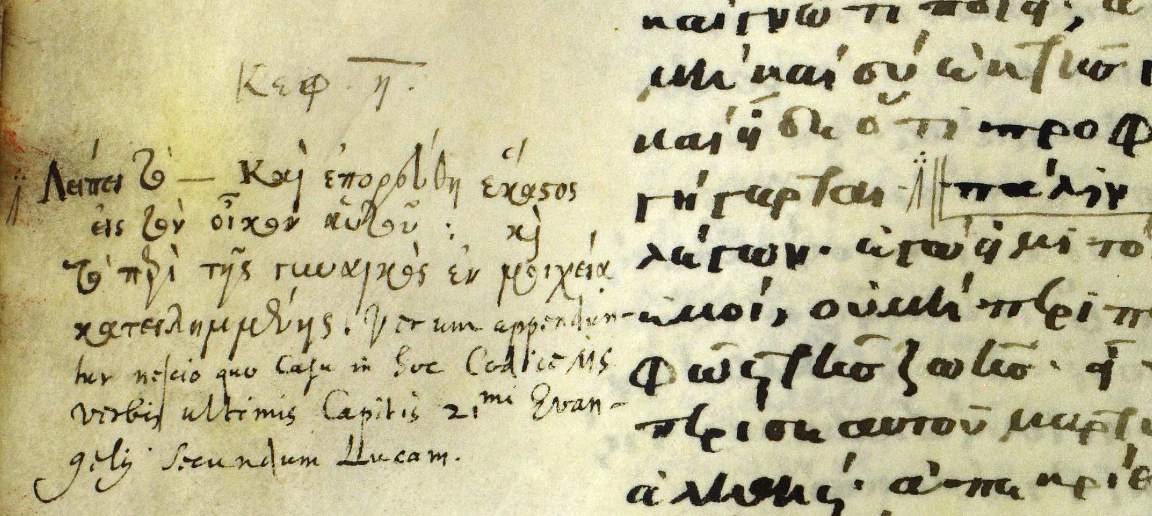
GA 69
Insertion at Luke 21
Folio 66b - Luke ch 21:26-38
(& adding Jn 7:53-8:11)This page shows the addition of the PA at line 27, (after Lk 21:38).
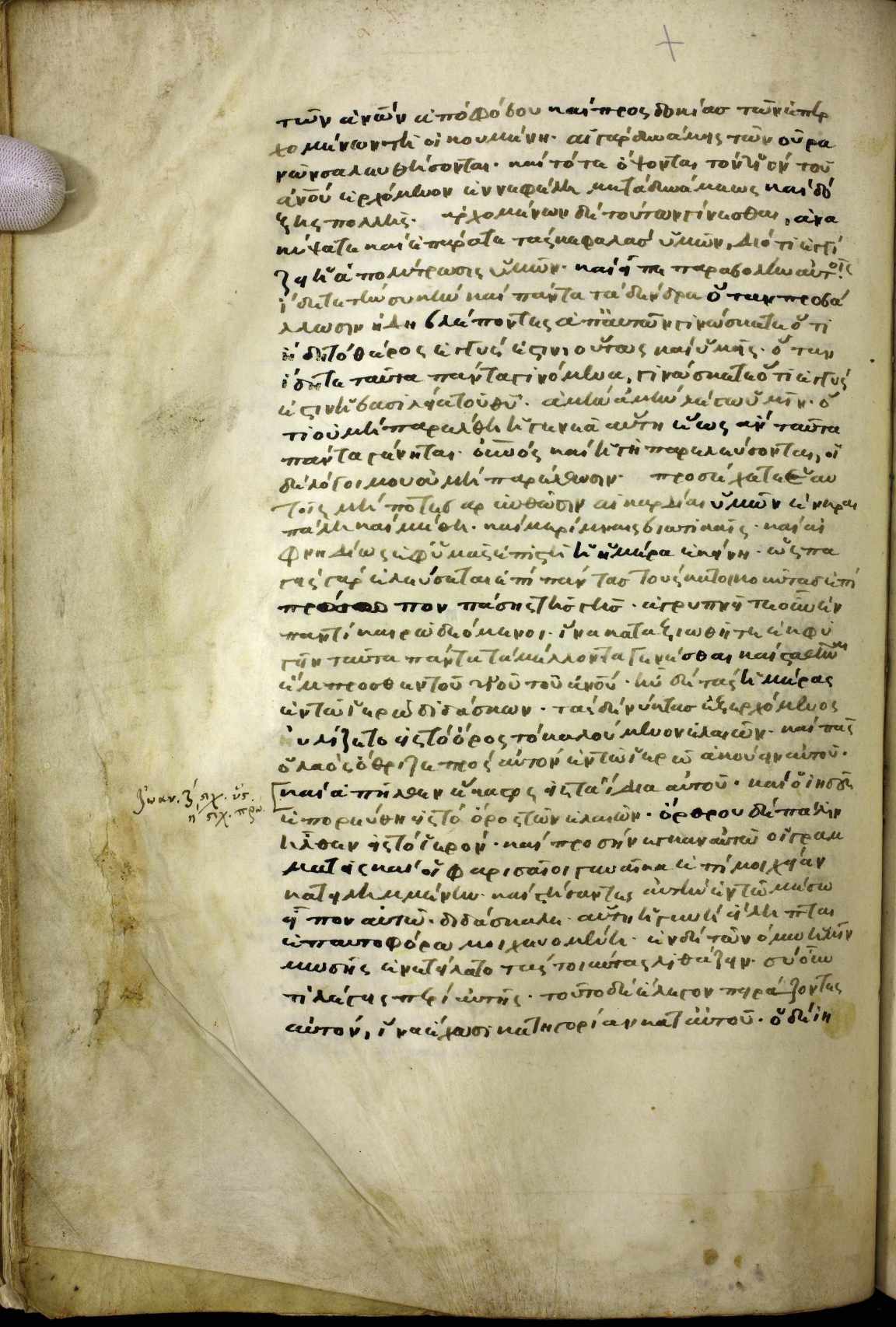
Left Margin of Insertion:
Added note, apparently from same hand as in marginal note.
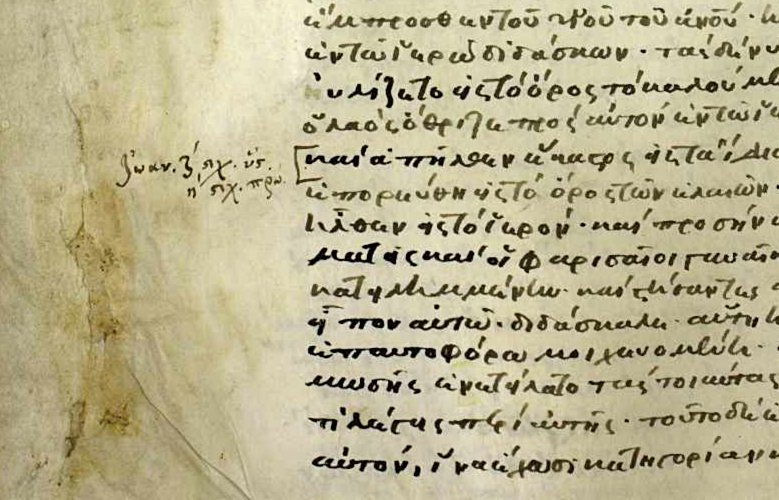
Right Margin of Insertion:
An unusual but not unfamiliar "dot" indicating the stop of Luke's text, and the start of the Pericope.

GA 69
Folio 67a - Luke ch 22:1
(Jn 7:53-8:11 cont. & Luke 22:1...)This page shows the continuation of the PA and Luke 22:1...fwd.
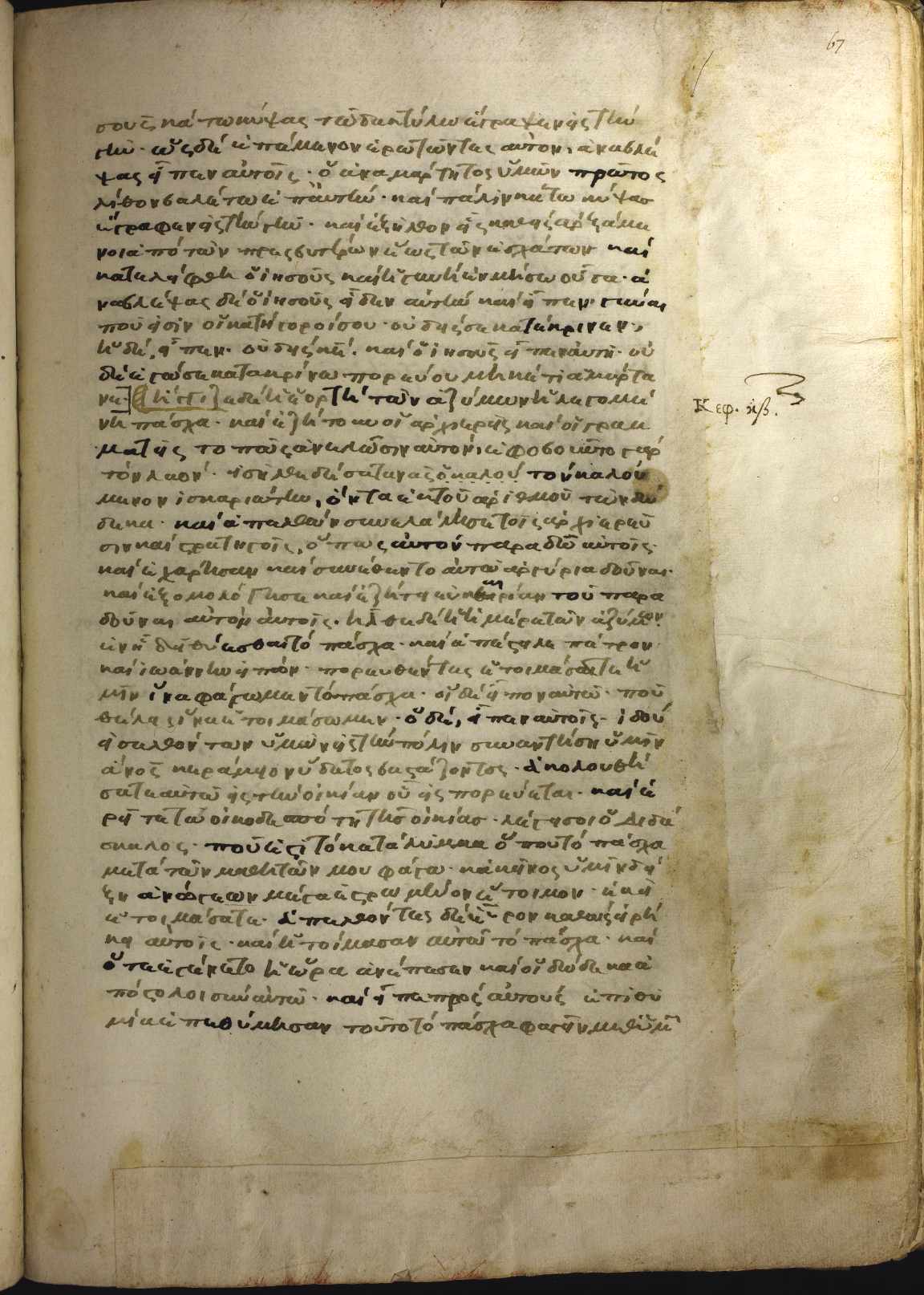
Left Margin of Insertion:
Added brackets[!], apparently from same hand as the original scribe, and done with the same ink and pen. This copyist was obviously aware that this was an insertion of foreign material into Luke.
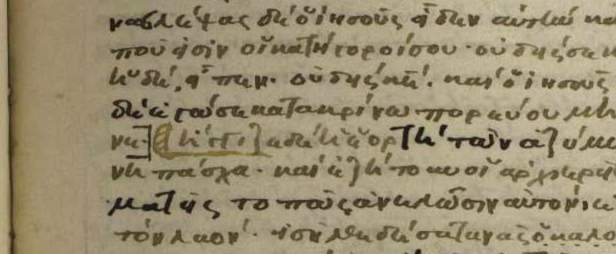
Right Margin of Insertion:
Added note, apparently from same hand as in marginal notes elsewhere. Written overtop the repair-seam, it was obviously added after the repair/extension of the page margins.
